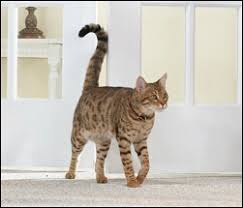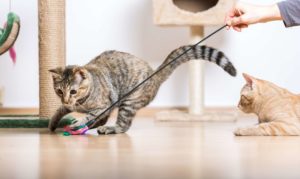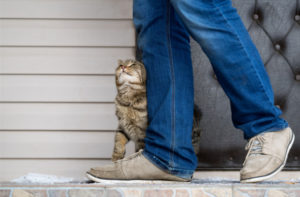A Kitty’s Tail Tells the Tale

Did you know that the position of your cat’s tail affords you a valuable insight as to her frame of mind? But do you know the various positions her expressive tail can assume and what they may mean? If not, paw-lease read on …
When your cat’s tail is upright, this indicates that she’s feeling social and confident. Should she approach you in a friendly manner with her tail up, it’s an open invitation for you to pet her or play with her.
When your cat’s tail resembles a hook or a question mark, standing upright with a curl at the end, this again indicates that she’s happy and is approaching you amicably for attention. Although you may be tempted to pet her curly-tipped tail, most cats prefer being petted around the facial glands on their cheeks, next to their ears and under their chins.
When your cat drops her tail below the level of her back, she’s either anxious or frightened. If, however, her tail is tucked between her legs, she may be truly terrified or in terrible pain.
When your cat assumes that iconic “Halloween” pose with her back arched and her tail puffed, she’s clearly been startled or frightened by a sudden perceived threat such as the sight of other animals outside, visitors to your home or an unexpected, loud noise. A cat’s hair stands on end (piloerection) in order for her to appear larger than she is. Should she assume this defensive position around you, she’s letting you know that she wants to be left alone. Should you attempt to interact with her while her back is arched and her tail is puffed, she may perceive your approach as a threat and become aggressive.
When your cat is sitting or lying down with her tail wrapped around her body, she may be either frightened or defensive, in pain or feeling ill. Rather than trying to interact with her, look around you for any possible sources of stress. If you find none, and she sits or lies down with her tail curled tightly around her body for more than a few days, bring her to your veterinarian for a thorough examination and evaluation.
When your cat thrashes her tail or thumps it on the ground, she’s clearly annoyed, irritated or angry because this is known as a distance-increasing behavior. Example: if you’re petting her and she begins thrashing her tail or thumping it on the ground, she’s “telling” you to stop. If you don’t, this can lead to her hissing, growling, swatting or even biting you.
When your cat swishes her tail from side to side slowly, she’s most likely focused on a toy or some other object in your home and is preparing to pounce. Since “predatory” behavior such as stalking and pouncing is an excellent source of enrichment for her, sit back and allow her to “pursue” the object of her fascination.
When your cat quivers her tail, it indicates that she’s especially excited to see you or one of her feline companions. If, however, she quivers her tail while holding it straight up in the air and backing up against a vertical surface like a wall, a door or a piece of furniture, she may be urine marking.
When your cat wraps her tail around you, it’s her way of “hugging” you and letting you know that she’s extremely eager to interact with you. Could any gesture be more paws-itive or more purr-fect than this?




